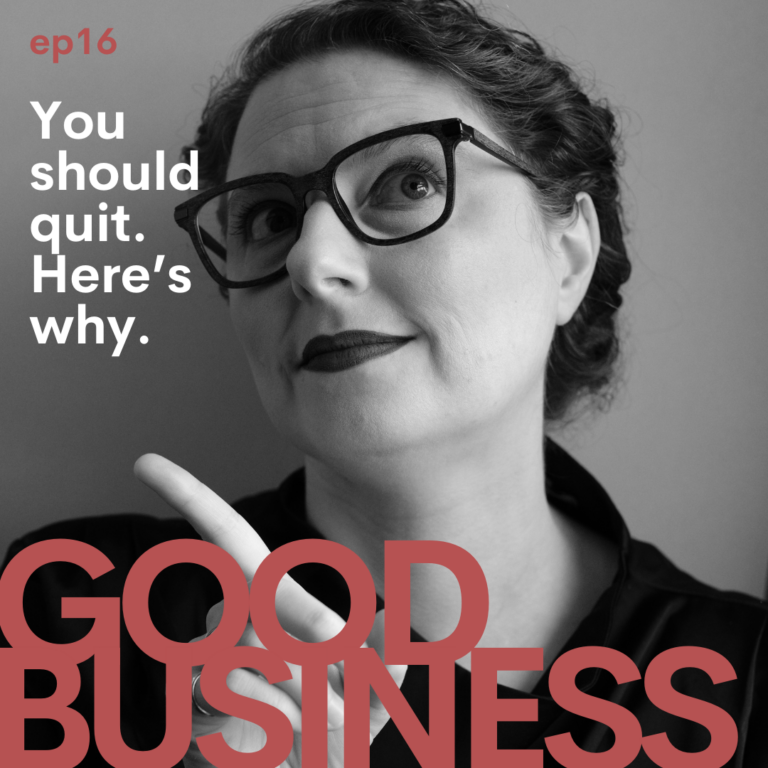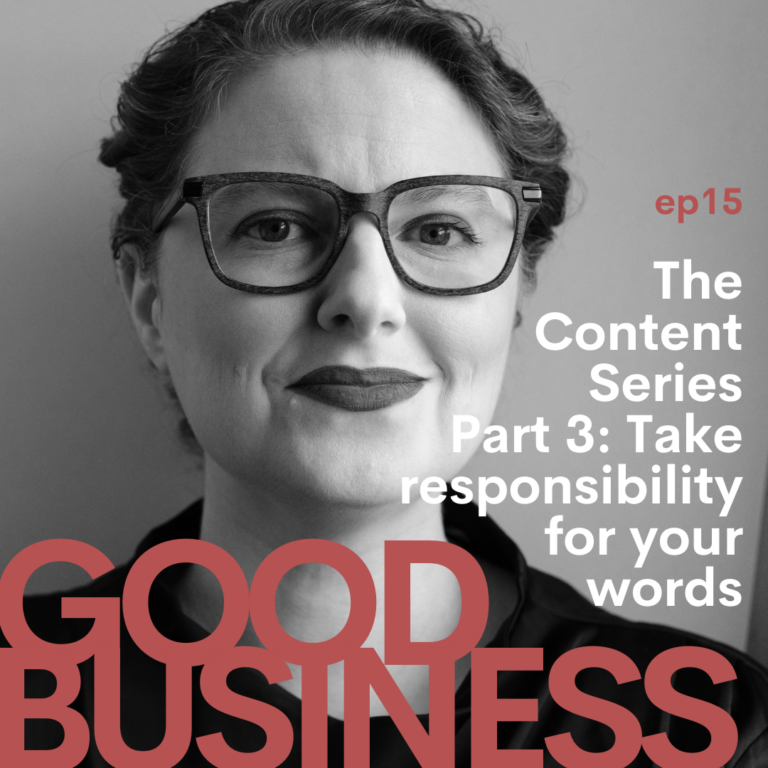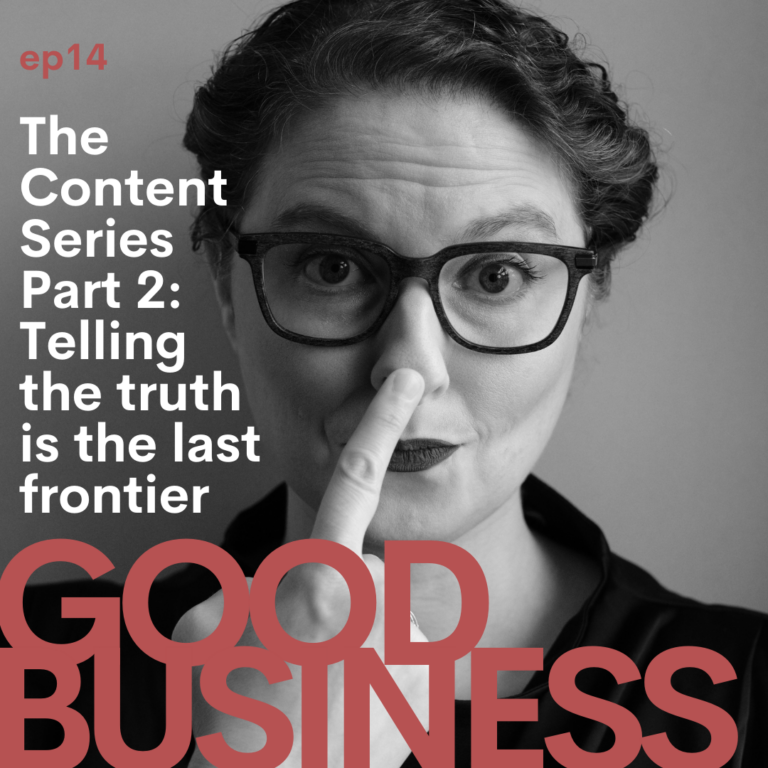Welcome back to The Good Business Podcast. I’m your host, Illana Burk. Today, we’re talking about the very complicated moment when you realize that it’s time to make a significant change in your work. And these moments are never easy. Even when they’re happening on your terms – as opposed to being backed into a corner – it can still be really overwhelming.
And the longer you’ve been in business, and doing it one way, the harder it can be to conceptualize big changes.
After all, there’s a really big difference between taking big swings when you’re young and exploring with what feels right and when you’re older and more established and throwing spaghetti at a wall starts feeling a lot more like wasting a perfectly good dinner than fun experimentation.
Whatever your circumstances, the risks and complexity make pivots hard. So today, we’re going to talk about
how to recognize the need for a pivot,
how to evaluate the core of your business so you know what to keep,
how to approach researching your market to look for trends you can potentially capitalize on, how to soft pivot and communicate changes,
and finally how to think about embracing the whole process.
First, it’s important to be able to actually recognize and identify the signs that a pivot might be necessary. I have five things to look out for around this:
- 1. Stagnant or Declining Sales: If your revenue has plateaued or taken a downturn, it might be time to reevaluate your offerings.
- 2. Customer Feedback/lack of effectiveness: Negative feedback or repeated requests for something your business doesn’t currently offer can indicate a mismatch between what you provide and what your customers want.
- 3. Market Shifts: Changes in your industry, new competitors, or emerging technology and platforms can make your current business model outdated.
- 4. Burnout or Lack of Passion: If you no longer feel excited or motivated by your business, it could be a sign that you need to shift focus.
- 5. Product or Service Misalignment: If your product or service isn’t solving a significant problem, or your community isn’t connecting with it, a pivot may be necessary.
Once you see that change is necessary, the next step is to figure out what to keep. You do this by evaluating and identifying the core competencies of your work.
Some of the best ways to do this include going back to basics and answering some of the questions you probably haven’t really articulated since you started – if at all.
Thoise questions might include:
-
- What is your unique value proposition?
- Who are your ideal and favorite clients, and have their needs changed?
- Which aspects of your business are working well?
- Where are you seeing the most resistance or challenges?
- What’s your biggest vision for the impact you want to have? And are there ways you can recalibrate towards that vision without tearing eeeevrything down?
The idea is to identify which elements of your business are non-negotiable and which are flexible. Sometimes, a pivot doesn’t mean starting from scratch but rather adjusting your approach to better align with what your people want and need now – rather than what you want them to need..
Next, research what’s actually happening both in your market and with the technology and trends that affect it.
After recognizing the need for a pivot, it’s crucial to understand the current landscape. This will help ensure that the change you’re considering is informed by reality, not just gut instinct.
- Market Trends: What’s happening in your industry? Are there emerging trends or technologies that you need to adopt? Keep an eye on where your market is heading.
- Client issues and struggles: Dive deep into what your customers are saying. Conduct surveys, interviews, or analyze social media feedback to identify their biggest challenges and desires.
- Competitor Analysis: Look at what your competitors are doing. How are they adapting to changes in the market? Are there gaps that you can fill with your pivot?
The next step is to Test the Waters with a Soft Pivot
Your pivot doesn’t have to happen all at once. If possible, start with small pieces of the puzzle to test the response from your audience.This can be done in a few ways…
- You could launch a new product or service in beta by launching a smaller version or beta test it with a limited group of customers. Share your thinking, and look for ways to collaborate with your people.
- Marketing Experimentation: If you’re thinking of targeting a new demographic or changing your messaging, start with an ad campaign or a social media push to gauge interest. And you can always go directly to a few people who you think would be a good fit and simply ask them if they would be interested in being a guinea pig.
By starting small, you minimize risk and gain valuable insights before committing to a full-scale pivot.
Once you’re ready to fully pivot, communicating what you’re doing to your customers, team, and stakeholders is key so they understand why the change is happening and how it will benefit them.
This means you need to map out and deliver three separate forms of communication with three separate needs:
- First, Internal Communication: If you have a team, don’t just dictate what’s happening – loop them in on the process early. They may have insights or ideas that can help shape the pivot. Plus, a united front is essential when navigating change. Getting team buy-in can be the difference between a smooth shift and a very bumpy one.
- Second, Customer Messaging: This is the direct communication with your people. Be transparent with your customers about why you’re pivoting. Frame the change as a positive move toward growth and show them how it will better serve their needs. Or, if you’re moving away from your current clientele, engage them in that shift. Happy past clients might be your best referrers in your new direction.
- Third, External Marketing: Update your marketing materials, website, and social media to reflect the new direction. Make sure your branding aligns with the pivot so customers aren’t confused.
Finally, the whole process requires that you embrace the opportunity for growth.
While a pivot can be really really hard, it’s also a pretty amazing opportunity. Many of the most successful companies out there have pivoted at some point in their trajectory. For example, Instagram started as a location-based app called Burbn before pivoting to focus on photo sharing. Netflix transitioned from a DVD rental service to a streaming giant. Adapting to changing conditions is everything when you’re trying to build something sustainable.
Your business pivot can lead to all kinds of cool breakthroughs. By approaching the process thoughtfully and deliberately, gathering data, and staying nimble, you’ll set yourself up well for long-term growth and sustainability.
More Episodes
Why trust-building beats list-building every day of the week | GB19
Today’s episode is all about why focusing on listbuilding as your primary focus in client acquisition is the very best way to feel like you’re banging your head against a wall. It’s also the very best way to make the people you MOST want to connect with feel like the only think that matters to you about THEM is their email address.
CEO Mindset: Looking into the dark | GB18
Today’s episode is on one area of what people call the ‘CEO Mindset’. First, we’ll dig in a little to what people THINK this means. Then, we’ll talk through what it ACTUALLY means. And finally, we’ll wrap up with some simple truths about how to do this better and why doing so is necessary to actually grow.
What to do when you just can’t get fired up about a great idea | GB17
Today’s episode is all about what to do when you’re working on something that you love but you can’t figure out why it just. isn’t. working. First, we’ll talk about what it feels like to love something but not be lit UP by it. Then we’ll talk about what to do about it and how to fix it. And finally, we’ll wrap up with some inspiring examples of how this works in action.
Are you a quitter? Because the world needs more quitters. | GB16
Quitting usually comes with shame. It feels like bad decisions and ignorance and can certainly be predicated on failure, but it is, and will always be a choice that is 100% within your control. You can’t be forced to quit. You...
The Content Series: Take responsibility for your words | GB15
Gone are the days of taking out an ad in the local newspaper to get foot traffic. When you start a business this day in age, you have to not only have something to SELL, you have to have something to SAY.
The Content Series: Why telling the truth is the only content strategy left | GB14
Today’s episode is all about the last frontier of content marketing: The bold notion that you can tell the whole truth and people will buy whatever you’re selling.






